
print, engraving
#
dutch-golden-age
# print
#
old engraving style
#
landscape
#
19th century
#
cityscape
#
engraving
Dimensions: height 168 mm, width 200 mm
Copyright: Rijks Museum: Open Domain
Editor: This is "Gezicht op Acquoy" by Hermanus Petrus Schouten, created sometime between 1762 and 1822. It’s an engraving of a small town, very detailed. What really strikes me is the way the buildings dominate the scene, dwarfing the people. How do you interpret this work? Curator: Well, considering its place within art history, and bearing in mind that prints were relatively accessible, I wonder about the intended audience for this image. Was this made for people from Acquoy to perhaps show pride in their home, or for those outside to get a sense of Dutch village life? Editor: That’s a great question. I hadn't considered the purpose of its distribution. Does the architectural style suggest anything about the socio-economic conditions of the time? Curator: Absolutely. Look at the church and the well-maintained houses. It implies a certain level of established social order and possibly some degree of prosperity within this community. The choice of a cityscape as a subject is also telling; how might it function as a kind of visual record, showcasing this particular location during a period of significant social and political transformation in Europe? Editor: So, it's not just a pretty picture, but almost a document of its time. Is it common for prints from this period to highlight these ordinary scenes? Curator: It became increasingly popular. With the rise of a middle class and the evolving roles of civic engagement, there was growing interest in depicting everyday life and local identities, breaking away from purely religious or aristocratic subject matter. Editor: I see! Understanding the historical and social factors definitely adds layers of meaning to the artwork. Curator: Indeed! Art doesn't exist in a vacuum, and understanding its place within a larger historical narrative enriches our understanding of the artist’s choices and their potential impact. Editor: That’s made me think about how art reflects the world it’s created in. I'll definitely be researching more on Dutch socio-political history from this period!
Comments
No comments
Be the first to comment and join the conversation on the ultimate creative platform.













